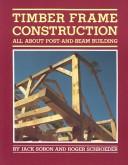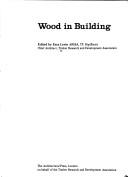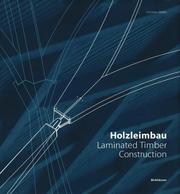| Listing 1 - 10 of 19 | << page >> |
Sort by
|
Book
ISBN: 1439917647 Year: 2018 Publisher: Philadelphia, Pennsylvania : Temple University Press,
Abstract | Keywords | Export | Availability | Bookmark
 Loading...
Loading...Choose an application
- Reference Manager
- EndNote
- RefWorks (Direct export to RefWorks)
Carpentry --- Building, Wooden --- History. --- Building with wood --- Wood construction --- Wooden architecture --- Wooden building --- Building --- Manual training --- Woodwork

ISBN: 0882663658 Year: 1984 Publisher: Pownal Garden Way Publishing
Abstract | Keywords | Export | Availability | Bookmark
 Loading...
Loading...Choose an application
- Reference Manager
- EndNote
- RefWorks (Direct export to RefWorks)
Houtconstructies ; houtarchitectuur ; naslagwerken --- Skeletbouw ; houtskeletbouw --- Bouwmaterialen ; hout --- 691.11 --- Building, Wooden. --- Wooden-frame houses --- Design and construction. --- Building, Wooden --- Wood construction --- Wooden architecture --- Wooden building --- Building --- Design and construction --- Building with wood
Book
ISBN: 3030875741 303087575X Year: 2022 Publisher: Cham, Switzerland : Springer,
Abstract | Keywords | Export | Availability | Bookmark
 Loading...
Loading...Choose an application
- Reference Manager
- EndNote
- RefWorks (Direct export to RefWorks)
Building, Wooden. --- Sustainable buildings. --- Sustainable construction. --- Green construction --- Building --- Sustainable engineering --- Ecologically sustainable buildings --- Environmentally sustainable buildings --- Green buildings (Green technology) --- Buildings --- Sustainable development --- Building with wood --- Wood construction --- Wooden architecture --- Wooden building

ISBN: 0851397166 Year: 1971 Publisher: London Architectural press
Abstract | Keywords | Export | Availability | Bookmark
 Loading...
Loading...Choose an application
- Reference Manager
- EndNote
- RefWorks (Direct export to RefWorks)
Building, Wooden --- 691.11 --- Wood construction --- Wooden architecture --- Wooden building --- Building --- Wood. Timber. Wood products --- Building, Wooden. --- Wood. --- 691.11 Wood. Timber. Wood products --- Wood --- Building materials --- Forest products --- Trees --- Timber --- Environmental Sciences and Forestry. Forestry -- Forest Products -- Wood and Wood Products --- ALLW. --- Building with wood
Book
ISBN: 0810917718 Year: 1989 Publisher: New York (N.Y.) Harry N. Abrams
Abstract | Keywords | Export | Availability | Bookmark
 Loading...
Loading...Choose an application
- Reference Manager
- EndNote
- RefWorks (Direct export to RefWorks)
The vast region of northern Russia, including Siberia, heavily forested with firs, pines, larch and birch trees, is the biggest and richest area in the world for buildings of all types made of wood. Written by two acknowledged experts in the field, this fascinating book examines the whole range of wooden structures in the region, with more than 250 illustrations, 40 in color. The Siberian settlements, mostly founded in the seven- teenth century by Cossack adventurers and fur traders, had massive timber fortifications. Log houses were built wherever the pioneers went and churches arose even in the most remote places. It was in the northern part of European Russia, however, that some of the world's most impressive, unusual, and beautiful wooden structures were produced. The isolation and inaccessibility of the villages in the northern forest zone, together with the scarcity of brick or stone, account for the immunity of north Russian timber building to outside influence. Many of these hamlets did not possess a single masonry building until the seventeenth century, nor had most of the inhabitants ever seen one. This volume presents a diversity of wooden structures, from huge cathedrals to miniature churches and monasteries, large houses, izbi, hunters' cabins, barns, wind- mills, grim fortress towers, little-known settlements, and famous reconstructions of whole groups of buildings, as in Kizhi. The special character of these buildings-inext cable from their setting and from the way of life that supported them-is evoked in a way that has never before been realized, drawing on the authors' unique archive of photographs, drawings and watercolors. The wealth of remarkable documentary material is complemented by the breathtaking color photographs taken by Vadim Gippenreiter, the great Russian photographer, who has for many years recorded with zeal the landscapes and wooden buildings of the far north and east. David Buxton, the foremost authority on the wooden churches of eastern Europe, has contributed an illuminating introduction, written from his own experience as a traveler in those remote regions since 1928.
72.03 --- 691 --- 691.1 --- 693.9 --- Rusland --- Architectuurgeschiedenis --- Bouwmaterialen (architectuur) --- Hout --- Houtconstructies --- Houtskeletbouw --- Vakwerkbouw --- Building, Wooden --- Wood construction --- Wooden architecture --- Wooden building --- Building --- Building with wood --- Kerkbouw ; Rusland ; geschiedenis --- Vernaculaire ; traditionele architectuur ; Rusland --- Houtarchitectuur ; Rusland --- Architectuur ; Rusland ; geschiedenis --- 691.11 --- Bouwmaterialen ; hout
Book
ISBN: 3481003269 Year: 1993 Publisher: Köln Müller
Abstract | Keywords | Export | Availability | Bookmark
 Loading...
Loading...Choose an application
- Reference Manager
- EndNote
- RefWorks (Direct export to RefWorks)
Building --- Building, Wooden. --- Details. --- Houtarchitectuur --- Houtconstructies ; houtarchitectuur ; naslagwerken --- 691.11(03) --- Bouwmaterialen ; hout ; naslagwerken --- building materials --- hout --- wood [plant material] --- Building materials. Building technology --- Materials sciences --- Architecture --- bouwmaterialen --- Building, Wooden --- Buildings --- Building with wood --- Wood construction --- Wooden architecture --- Wooden building --- Details
Book
ISBN: 342102524X Year: 1978 Publisher: Stuttgart Deutsche Verlags-Anstalt
Abstract | Keywords | Export | Availability | Bookmark
 Loading...
Loading...Choose an application
- Reference Manager
- EndNote
- RefWorks (Direct export to RefWorks)
Building, Wooden --- 694 --- 694 Timber construction. Carpentry. Joinery --- Timber construction. Carpentry. Joinery --- Wood construction --- Wooden architecture --- Wooden building --- Building --- Wood --- Building materials --- Forest products --- Trees --- Timber --- Building, Wooden. --- Wood. --- Environmental Sciences and Forestry. Forestry -- Forest Products -- Wood and Wood Products --- ALLW. --- Building with wood
Book

ISBN: 3868599630 9783868599633 3868596631 Year: 2021 Publisher: Berlin/Boston De Gruyter
Abstract | Keywords | Export | Availability | Bookmark
 Loading...
Loading...Choose an application
- Reference Manager
- EndNote
- RefWorks (Direct export to RefWorks)
Als organisches Baumaterial erfährt Holz in Zeiten der Klimakrise eine besondere Wertschätzung. Eingebunden in umweltschonende Ressourcenkreisläufe zeigt sich seine Innovationskraft, wenn es als Material Bestandteil neuer technologischer Entwicklungen und hybrider Verwendungen wird, die aktuellen und komplexen architektonischen Aufgaben gewachsen sind. Das neue Denken des Materials Holz als hochmodernem und veränderlichem Baustoff der Zukunft hat gerade erst begonnen.GAM. 17 nimmt Holz in seiner Vielschichtigkeit und seinem architektonischen Potenzial neu in den Blick und stellt dabei konstruktive und gestalterische Konzepte vor, die die Möglichkeiten des Materials für eine klimafreundlichere Bauwirtschaft ausloten. Ergänzt wird dies durch einen Rückblick in die Geschichte des Holzbaus und seine ideologischen Verstrickungen, die die Weiterentwicklung des Baustoffs lange erschwert haben. Mit Beiträgen von Reyner Banham, Urs Hirschberg, Anne Isopp, Jens Ludloff, Laila Seewang, Stephan Trüby, Anselm Wagner und anderen. As an organic building material, wood is held in particularly high esteem in this age of climate crisis. A component of environmentally friendly resource cycles, wood demonstrates its innovative potential when used in new technological developments and hybrid applications that are suited to complex, modern architectural tasks. We have only just started reimagining wood as a cutting-edge, versatile building material of the future. GAM. 17 takes a new look at wood--at its multi-faceted nature and architectural possibilities-- and proposes building and design concepts that fully utilize the material's potential for a more climate-friendly construction industry. This is further complemented by a look back at the history of building with wood and the ideological entanglements that have long stood in the way of the further development of wood as a building material. With contributions by Reyner Banham, Urs Hirschberg, Anne Isopp, Jens Ludloff, Laila Seewang, Stephan Tr|by, Anselm Wagner, and others.
Building, Wooden. --- Wood. --- Building materials --- Forest products --- Trees --- Timber --- Building with wood --- Wood construction --- Wooden architecture --- Wooden building --- Building --- Architecture --- building material --- sustainable building --- building material of the future --- climate-friendly building industry --- Sustainable --- Environmentally friendly --- Rethinking --- Climate crisis --- Climate-friendly --- Technological development --- Wood --- Organic building materials
Book
ISBN: 2735101460 9782735101467 2735120481 Year: 1985 Volume: no 2
Abstract | Keywords | Export | Availability | Bookmark
 Loading...
Loading...Choose an application
- Reference Manager
- EndNote
- RefWorks (Direct export to RefWorks)
Les architectures de terre et de bois d’époque romaine étaient, il y a quelques années encore, très mal connues. Des fouilles récentes ont apporté de nombreuses données. Cet ouvrage tente un premier point : s’agit-il de survivances protohistoriques ? comment se présentent ces techniques de construction ? à quelles conditions socio-économiques répondent-elles ? L’approche archéologique et textuelle s’accompagne des enseignements livrés par des expériences contemporaines. Earth and wood constructions of the Roman era were, until several years ago, very little known. Recent excavations have provided us with considerable information. This work attempts to answer primary questions such as : are these protohistorical survivals ? what construction techniques were used ? what socio-economic conditions do they correspond to ? The textual and archaeological approach go along with informationobtained by contemporary experiments.
City planning --- Planification urbaine --- Building, Wooden --- Earthworks (Archaeology) --- Congresses --- Europe --- Gaul --- Antiquities --- Buildings, Wooden --- Congresses. --- Wood construction --- Wooden architecture --- Wooden building --- Building --- Excavations (Archaeology) --- Fortification, Prehistoric --- Gallia --- Gaule --- Council of Europe countries --- Eastern Hemisphere --- Eurasia --- Antiquités --- Congrès --- Building with wood --- Building, Wooden - Europe - Congresses --- Building, Wooden - Gaul - Congresses --- Earthworks (Archaeology) - Europe - Congresses --- Earthworks (Archaeology) - Gaul - Congresses --- Europe - Antiquities - Congresses --- Gaul - Antiquities - Congresses --- habitat --- Moyen Âge --- Antiquité --- Protohistoire --- monde romain --- province occidentale --- INDE --- GEOGRAPHIE URBAINE --- VILLES

ISBN: 9783764362676 3764362677 Year: 2000 Publisher: Basel Birkhäuser
Abstract | Keywords | Export | Availability | Bookmark
 Loading...
Loading...Choose an application
- Reference Manager
- EndNote
- RefWorks (Direct export to RefWorks)
Building, Wooden --- Laminated wood --- Construction en bois --- Constructions à ossature de bois --- Bois lamellé collé --- #KVIV:BB --- 691 --- 691.1 --- 691.116 --- Laminated materials --- Engineered wood --- Veneers and veneering --- Wood construction --- Wooden architecture --- Wooden building --- Building --- Bouwmaterialen (architectuur) --- Hout --- Houtconstructies --- Laminaat --- Laminated wood construction. --- Laminated wood construction --- Construction, Laminated wood --- Laminated timber construction --- Wood laminate construction --- Engineered wood construction --- Construction en bois. --- Constructions à ossature de bois. --- Bois lamellé collé. --- Building, Wooden.
| Listing 1 - 10 of 19 | << page >> |
Sort by
|

 Search
Search Feedback
Feedback About
About Help
Help News
News